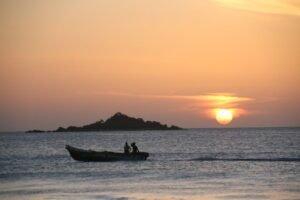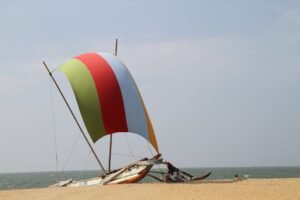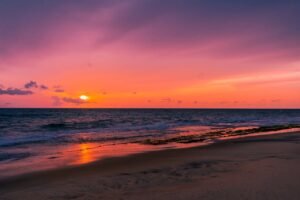- +94 11 2 57 46 46
- inbound@travelco.lk
- 333 3/1 Galle Road, Colombo 03
Negombo
Negombo is a city in Sri Lanka that has many sites to visit.
As a matter of fact, many travellers overlook this beautiful city because there is no proper guide that someone can get.
However, in this article, we will be changing it.
Which means that we will be sharing with you the best five places that you can visit in Negombo to get some amazing experiences.
Therefore, let’s get into these places and see what we can get from by visiting there.
Negombo Beach Park
Taking along the city’s western edge, Negombo Beach Park is a coastal paradise that has everything when it comes to tropical beaches.
The sand over there is slightly matching to the gold colour that seems to go on forever.
If you are with your family, we are sure that it will worth visiting there because you got plenty of space for relaxation and to do fun activities.
Speaking of fun activities, during the day, the beach is a paradise of activities.
Usually, local fishermen prepare their traditional catamarans, while tourists and locals enjoy swimming, sunbathing, and trying out various water sports.
However, if you are thinking about the wave speed, you in the safe side here.
Because during the summer season, all the waves are calm by making it perfect for swimmers of all skill levels.
Here’s something interesting: During the sunset, the beach turns into a breathtaking view.
The sky shifts through an incredible palette of colors that are from bright blues to warm oranges and deep purples by creating the most perfect backdrop for an evening walk.
In addition to that, you can find lots of spots to grab a bite when you feel hungry.
So, by any chance if you feel like getting something to eat you don’t have to travel anywhere further.
Because, locals around the area got vendors that are near the beach by selling out delicious street food and refreshing coconut water that adds to the lively atmosphere.
Negombo Dutch Fort
The Negombo Dutch Fort is a powerful reminder of Sri Lanka’s complex colonial history.
This place was built originally by the Portuguese in the 16th century and later reinforced by the Dutch in the 17th century.
Therefore, thanks to that in a way, this compact area tells an incredible story of maritime conquest and cultural changes that have happened.
Even though the original structure has been damaged over time. The remaining walls and strategic location have the capability to give visitors a slight connection to the historical period that Sri Lanka had.
Anyway, that’s enough of the history of it, let’s see what we can find in here.
Well, the fort’s architecture is a fascinating mix of European defensive design and local building techniques.
As you explore the remaining walls, you can almost imagine the historical vibe of this location.
Moreover, the surrounding area is equally fascinating as well, with the ancient-era buildings and local structures that shows how Negombo has developed over time.
Overall, to be honest this place is great if you are into the history.
Therefore, for history lovers, Negombo Dutch Fort will be a paradise.
Angurukaramulla Temple
Just from the name, we hope that you understood what this place is.
Well, yes, it is a temple.
The Angurukaramulla Temple is a wonderful spiritual and cultural place that gives out visitors a deep dive into the Sri Lankan Buddhist traditions.
This temple is located near the inland from the coastal area.
Angurukaramulla temple complex is famous for its incredible murals, impressive Buddha statues, and unique architectural designs.
The entrance is particularly memorable which shows us a massive Buddha statue that welcomes visitors with a sense of peace.
Inside the temple, you’ll find out walls that are covered in beautifully painted murals with the use of Buddhist stories and moral teachings.
The colours they have used to highlight the statutes and paintings are quite fascinating, and the details are on point to give us a clear idea of what is it that we are looking at.
So, if you ever felt like having a unique experience of Sri Lanka’s religious side, this temple is a must-visit place in your list.
Negombo Lagoon
The Negombo Lagoon is an ecological place that allows us to experience a unique perspective on the region’s natural environment.
Rather than a tourist spot, most people who are around likes to call this place as a heaven.
This is because, Negombo Lagoon is a crucial area that supports many marine life and on the other hand to livelihoods for local fishing communities.
Now, just because of their saying, you don’t have to believe that it is not worth visiting here.
Because there are boat tours that allows visitors to explore the deep connection of mangrove forests, traditional fishing techniques, and wildlife that are around.
In addition to that, birdwatchers will be particularly excited about the lagoon.
The reason for that is, there are many uncommon and resident bird species that calls this place as their home.
What’s more interesting is that the boat tours often provide opportunities to watch local fishermen who are practicing traditional fishing methods by using nets and small boats.
To be honest, these techniques that have been and will go on for generations.
Therefore, try on this experience while you are at Negombo.
Because the lagoon’s peaceful environment and surroundings are actually perfect for nature photography, relaxation, and understanding the coastal ecosystems.
Negombo Fish Market Complex
The Negombo Fish Market Complex, which is locally known as “Lellama,” is the main source of the city’s maritime economy.
It’s one of the largest fish markets in Sri Lanka, where hundreds of fishermen bring their daily catch for sale.
The market is actually crowded in the early morning hours.
This is because it is their peak time and around sunrise all the boats return with loaded fresh seafood.
Due to that reason, many locals tend to get here during the morning period to get fresh seafood creatures.
On the other hand, visitors can witness the interesting process of fish trading.
This happens, once the boats comes back to the complex with the negotiations between fishermen and buyers.
However, if you are interested, you can do the same as well. Kind note though, for foreigner’s the price could be little higher.
Moreover, the air around in here is filled with the smell of fresh seafood and a fascinating show of the day’s catch.
Whereas, various fish species, including tuna, sardines, and local varieties, are displayed on ice by showcasing the region’s marine biodiversity.
However, more than just a marketplace, it serves as a social area where community members interact, exchange news, and maintain traditional trading aspects.
Therefore, for photographers and cultural lovers, the market is an incredible location to capture the essence of Negombo’s maritime culture.
Negombo is so much more than just a typical beach destination as you may have heard before.
This city allows travellers to experience the wonder of Sri Lanka’s essence.
As you may already know by now, Negombo is actually a perfect place to get some memorable experiences for everyone.
Therefore, without thinking about it much, grab your essentials and list down your activities to book your trip.
Who knows this city could be your most favourite one out of all that you have ever visited before.



